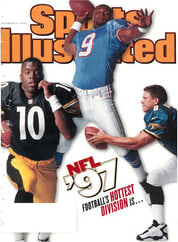
CATCHING UP WITH... QUARTERBACK BERT JONES SEPTEMBER 13, 1976
Folks in northern Louisiana like to refer to Bert Jones, the
former Baltimore Colts and Los Angeles Rams quarterback, as
"Bert, who's next to dirt." They don't mean it in a negative
sense but as a compliment: Jones is in harmony with the
Louisiana land he strives to preserve. "My father taught me to
enjoy the outdoors in a consumptive and nonconsumptive way,"
says Jones, who grew up hunting and fishing around his Ruston
home and has committed much of his post-NFL life to the
conservation of his state's public lands.
A jones for football was another thing passed from father to
son. Bert's dad, Dub, was a record-setting wide receiver for the
Cleveland Browns from 1948 to '55 and was an assistant coach
with the team from 1963 to '67, when Bert was a Browns ball boy.
"Adjusting to the NFL as a player wasn't that hard, because I
grew up in it," says Jones, now 46. "Guys like Paul Warfield
weren't just great players to me; they were friends. Same with
Jim Brown. I washed his jock and cleaned his locker every day."
As far as Colts fans were concerned, Jones couldn't carry Johnny
Unitas's jock after Bert was drafted out of LSU in 1973 to
succeed the Baltimore legend. The team was rebuilding and won
only six games in Jones's first two years, but then he led the
Colts to three straight AFC East titles. Jones threw for 59
touchdowns with only 28 interceptions in that span. His best
season was '76, when he threw for 3,104 yards and 24 touchdowns.
"We played as a team," says Jones, who still lives in Ruston,
with his wife, Danielle, and their four children. "We didn't
have that look-at-me individual attitude that you see today."
But all eyes were on Jones in '82, when a contract dispute ended
with Baltimore's trading him to L.A. He played four games with
the Rams before a neck injury forced him to retire. Jones
returned to Louisiana and with his older brother, Bill, opened a
lumber treatment mill.
In 1989 Jones was appointed to the state's Wildlife and
Fisheries Commission. During his first visit to the commission's
offices, which occupied a highly desirable French Quarter
building in New Orleans, Jones said, "Let's sell this place and
buy some dirt." The property was sold for $24 million, and that
money went toward the purchase of 200,000 acres of land for
public use. "The goal was to maintain property and protect
wildlife," Jones says. "Being a good steward for the land is the
norm for a Jones."
--RICHARD DEUTSCH
COLOR PHOTO: NEIL LEIFER [Cover of SPORTS ILLUSTRATED featuring Bert Jones]

